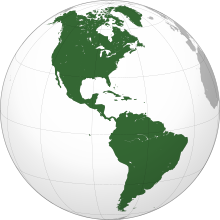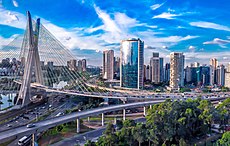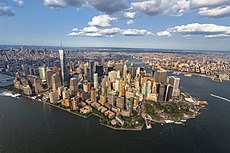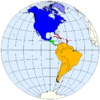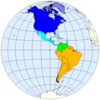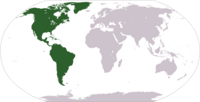Americas
| Area | 42,549,000 km2 (16,428,000 sq mi) |
|---|---|
| Population | 1.02 billion[1] |
| Population density | 22.67/km2(58.74/sq mi) |
| Demonym | American,[2]Pan-American,[3]New Worlder[4](seeusage) |
| Countries | 35 |
| Languages | Spanish,English,Portuguese,French,Haitian Creole,Quechua,Guaraní,Aymara,Nahuatl,Dutch,andmany others |
| Time zones | UTC−10:00toUTC |
| Largest cities | List
CompleteList of largest metropolitan areasand theircities |
| UN M49code | 019– Americas001– World |

TheAmericas,sometimes collectively calledAmerica,[5][6][7]known initially asIndia Nova,[8]are a landmass comprising the totality ofNorth AmericaandSouth America.[8][9][10]The Americas make up most of the land inEarth'sWestern Hemisphereand comprise theNew World.[5]
Along with theirassociated islands,the Americas cover 8% of Earth's total surface area and 28.4% of its land area. The topography is dominated by theAmerican Cordillera,a long chain of mountains that runs the length of the west coast. The flatter eastern side of the Americas is dominated by large river basins, such as theAmazon,St. Lawrence River–Great Lakes,Mississippi,andLa Platabasins. Since the Americas extend 14,000 km (8,700 mi) from north to south, the climate and ecology vary widely, from the arctictundraofNorthern Canada,Greenland,andAlaska,to thetropical rainforestsinCentral Americaand South America.
Humans firstsettled the AmericasfromAsiabetween 20,000 and 16,000 years ago. A second migration ofNa-Dene speakersfollowed later from Asia. The subsequent migration of theInuitinto theneoarcticc. 3500 BCEcompleted what is generally regarded as the settlement by theIndigenous peoples of the Americas.
The first known European settlement in the Americas was by theNorseexplorerLeif Erikson.[11]However,the colonizationnever became permanent and was later abandoned. The Spanishvoyages of Christopher Columbusfrom 1492 to 1504 resulted in permanent contact with European (and subsequently, otherOld World) powers, which eventually led to theColumbian exchangeand inaugurated a period ofexploration,conquest, and colonizationwhose effects and consequences persist to the present. The Spanish presence involved theenslavementof large numbers of the indigenous population of America.[12]
Diseases introduced fromEuropeandWest Africadevastated the indigenous peoples,and the European powerscolonized the Americas.[13]Massemigration from Europe,including large numbers ofindentured servants,andimportation of African slaveslargely replaced the indigenous peoples in much of the Americas.
Decolonization of the Americasbegan with theAmerican Revolutionin the 1770s and largely ended with theSpanish–American Warin the late 1890s. Currently, almost all of the population of the Americas resides in independent countries; however, the legacy of the colonization and settlement by Europeans is that the Americas share many common cultural traits, most notablyChristianityand the use of West European languages: primarilySpanish,English,Portuguese,French,and, to a lesser extent,Dutch.
The Americas are home to more than a billion inhabitants, two-thirds of whom reside in theUnited States,Brazil,andMexico.It is home to eightmegacities(metropolitan areaswith 10 million inhabitants or more):Greater Mexico City(21.2 million),São Paulo(21.2 million),New York City(19.7 million),Los Angeles(18.8 million),Buenos Aires(15.6 million),[14]Rio de Janeiro(13.0 million),Bogotá(10.4 million), andLima(10.1 million).
Etymology and naming

The name "America" was first recorded in 1507. A two-dimensional globe created byMartin Waldseemüllerwas the earliest recorded use of the term.[16]The name was also used (together with the related termAmerigen) in theCosmographiae Introductio,apparently written byMatthias Ringmann,in reference to South America.[17]It was applied to both North and South America byGerardus Mercatorin 1538. "America" derives fromAmericus,theLatinversion of Italian explorerAmerigo Vespucci's first name.
The feminine formAmericawas originally used to refer to the newly discovered continent, which is why it was accorded with the feminine names of the other continents:Asia,Africa,andEuropa.[18]
Since the 1950s,[19]however, North America and South America have generally been considered by English speakers as separate continents, and taken together are calledthe Americas,or more rarelyAmerica.[20][21][5]When conceived as a unitary continent, the form is generallythe continent of Americain the singular. However, without a clarifying context, singularAmericain English commonly refers to theUnited States of America.[5]
History
Pre-Columbian era
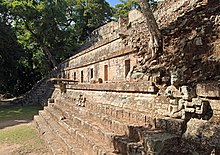
The pre-Columbian era incorporates allperiod subdivisionsin thehistory and prehistory of the Americasbefore the appearance of significant European influences on the American continents, spanning the time of theoriginal settlementin theUpper PaleolithictoEuropean colonizationduring theEarly Modern period.The termPre-Columbianis used especially often in the context of the greatindigenous civilizations of the Americas,such as those ofMesoamerica(Olmec,Toltec,Teotihuacano,Zapotec,Mixtec,Aztec,Maya) and theAndean civilizations(Inca,Moche,Chavín,Muisca,Cañari).
Many pre-Columbiancivilizationsestablished characteristics and hallmarks which included permanent or urban settlements, agriculture, civic and monumental architecture, andcomplex societal hierarchies.Some of these civilizations had long faded by the time of the first permanent European arrivals (c. late 15th–early 16th centuries), and are known only througharcheologicalinvestigations. Others were contemporary with this period, and are also known from historical accounts of the time. A few, such as the Maya, had their own written records. However, most Europeans of the time viewed such texts as pagan, and much was destroyed in Christian pyres. Only a few hidden documents remain today, leaving modern historians with glimpses of ancient culture and knowledge.[22]
Settlement

The first inhabitantsmigrated into the Americas from Asia. Habitation sites are known inAlaskaandYukonfrom at least 20,000 years ago, with suggested ages of up to 40,000 years.[24][25][26]Beyond that, the specifics of thePaleo-Indianmigration to and throughout the Americas, including the dates and routes traveled, are subject to ongoing research and discussion.[27]Widespread habitation of the Americas occurred after theLate Glacial Maximum,from 16,000 to 13,000 years ago.[26][28]

The traditional theory has been that these early migrants moved into theBeringialand bridge between eastern Siberia and present-day Alaska around 40,000–17,000 years ago,[29]when sea levels were significantly lowered during theQuaternary glaciation.[27][30]These people are believed to have followed herds of now-extinctpleistocene megafaunaalongice-free corridorsthat stretched between theLaurentideandCordilleranice sheets.[31]Another route proposed is that, either on foot or usingprimitive boats,they migrated down the Pacific coast to South America.[32]Evidence of the latter would since have been covered by asea level riseof hundreds of meters following the last ice age.[33]Both routes may have been taken, although the genetic evidences suggests a single founding population.[34]Themicro-satellitediversity and distributions specific toSouth American Indigenous peoplesindicates that certain populations have been isolated since the initial colonization of the region.[35]
A second migration occurred after the initial peopling of the Americas;[36]Na Dene speakersfound predominantly in North American groups at varying genetic rates with the highest frequency found among theAthabaskansat 42% derive from this second wave.[37]Linguistsandbiologistshave reached a similar conclusion based on analysis ofAmerindian language groupsandABO blood group systemdistributions.[36][38][39][40]Then the people of theArctic small tool tradition,a broad cultural entity that developed along theAlaska Peninsula,aroundBristol Bay,and on the eastern shores of the Bering Straitc. 2500 BCEmoved into North America.[41]The Arctic small tool tradition, aPaleo-Eskimoculture branched off into two cultural variants, including thePre-Dorset,and theIndependence traditionsof Greenland.[42]The descendants of the Pre-Dorset cultural group, theDorset culturewas displaced by the final migrants from the Bering sea coast line, theThule people(the ancestors of modernInuit), by 1000CE.[42]
Norse colonization
Around the same time as the Inuit migrated into Greenland, Viking settlers began arriving inGreenlandin 982 andVinlandshortly thereafter, establishing a settlement atL'Anse aux Meadows,near the northernmost tip ofNewfoundland.[43]Contact between the Norse colonies and Europe was maintained, asJames Watson Curranstates:
From 985 to 1410, Greenland was in touch with the world. Then silence. In 1492 theVaticannoted that no news of that country "at the end of the world" had been received for 80 years, and the bishopric of the colony was offered to a certain ecclesiastic if he would go and "restore Christianity" there. He didn't go.[44]
Large-scale European colonization

Although there had been previoustrans-oceanic contact,large-scale European colonization of the Americas began with the first voyage ofChristopher Columbusin 1492. The first Spanish settlement in the Americas wasLa Isabelain northernHispaniola.This town was abandoned shortly after in favor ofSanto Domingo de Guzmán,founded in 1496, the oldest American city of European foundation. This was the base from which the Spanish monarchy administered its new colonies and their expansion. Santo Domingo was subject to frequent raids by English and Frenchpirates.
On the continent,Panama Cityon the Pacific coast of Central America, founded on August 15, 1519, played an important role, being the base for the Spanish conquest of South America. ConquistadorLucas Vázquez de AyllónestablishedSan Miguel de Guadalupe,the first European settlement in what is now theUnited States,on thePee Dee RiverinSouth Carolina.[45]During the first half of the 16th century, Spanish colonists conducted raids throughout theCaribbean Basin,bringing captives from Central America, northern South America, andFloridaback to Hispaniola and other Spanish settlements.[46]
France, led byJacques CartierandGiovanni da Verrazzano,[47]focused primarily on North America. English explorations of the Americas were led byGiovanni Caboto[48]and SirWalter Raleigh.The Dutch inNew Netherlandconfined their operations to Manhattan Island, Long Island, the Hudson River Valley, and what later became New Jersey. The spread of new diseases brought by Europeans and African slaves killed many of the inhabitants of North America and South America,[49][50]with a generalpopulation crash of Native Americansoccurring in the mid-16th century, often well ahead of European contact.[51]One of the most devastating diseases wassmallpox.[52]
European immigrants were often part of state-sponsored attempts to found colonies in the Americas. Migration continued as people moved to the Americas fleeingreligious persecutionor seeking economic opportunities. Millions of individuals were forcibly transported to the Americas asslaves,prisoners orindentured servants.
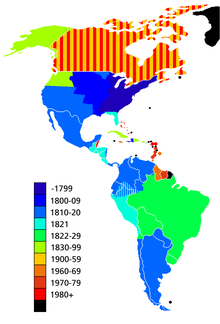
Decolonization of the Americasbegan with theAmerican Revolutionand theHaitian Revolutionin the late 1700s. This was followed by numerousLatin American wars of independencein the early 1800s. Between 1811 and 1825,Paraguay,Argentina,Chile,Gran Colombia,theUnited Provinces of Central America,Mexico,Brazil,Peru,andBoliviagained independence from Spain and Portugal in armed revolutions. After theDominican Republic won independence from Haiti,it was re-annexed by Spain in 1861, but reclaimed its independence in 1865 at the conclusion of theDominican Restoration War.The last violent episode of decolonization was theCuban War of Independencewhich became theSpanish–American War,which resulted in the independence ofCubain 1898, and the transfer of sovereignty overPuerto Ricofrom Spain to the United States.
Peaceful decolonization began with the United States's purchase ofLouisiana from Francein 1803,Florida from Spainin 1819, ofAlaska from Russiain 1867, and theDanish West Indies from Denmarkin 1916.Canadabecame independent of the United Kingdom, starting with theBalfour Declaration of 1926,Statute of Westminster 1931,and ending with thepatriation of the Canadian Constitutionin 1982. TheDominion of Newfoundlandsimilarly achieved independence under the Balfour Declaration and Statute of Westminster, but relinquished self-rule in 1934.[53]It was subsequentlyconfederated with Canadain 1949.
The remaining European colonies in the Caribbean began to achieve peaceful independence well afterWorld War II.JamaicaandTrinidad and Tobagobecame independent in 1962, andGuyanaandBarbadosboth achieved independence in 1966. In the 1970s, theBahamas,Grenada,Dominica,St. Lucia,andSt. Vincent and the Grenadinesall became independent of the United Kingdom, andSurinamebecame independent of the Netherlands.Belize,Antigua and Barbuda,andSaint Kitts and Nevisachieved independence from the United Kingdom in the 1980s.
Geography
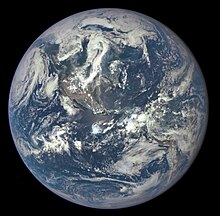
Extent
The Americas make up most of the land in Earth'sWestern Hemisphere.[54]The northernmost point of the Americas isKaffeklubben Island,which is the most northerly point of land on Earth.[55]The southernmost point is the islands ofSouthern Thule,although they are sometimes considered part ofAntarctica.[56]The mainland of the Americas is the world's longest north-to-south landmass. The distance between its two polar extremities,Murchison Promontoryon theBoothia Peninsulain northern Canada andCape Frowardin ChileanPatagonia,is roughly 14,000 km (8,700 mi).[57]The mainland's most westerly point is the end of theSeward Peninsulain Alaska;Attu Island,further off the Alaskan coast to the west, is considered the westernmost point of the Americas.Ponta do Seixasin northeastern Brazil forms the easternmost extremity of the mainland,[57]whileNordostrundingen,in Greenland, is the most easterly point of the continental shelf.
Geology
South America broke off from the west of the supercontinentGondwanaaround 135 million years ago, forming its own continent.[58]Around 15 million years ago, the collision of theCaribbean Plateand thePacific Plateresulted in the emergence of a series of volcanoes along the border that created a number of islands. The gaps in the archipelago of Central America filled in with material eroded off North America and South America, plus new land created by continued volcanism. By three million years ago, the continents of North America and South America were linked by theIsthmus of Panama,thereby forming the single landmass of the Americas.[59]TheGreat American Interchangeresulted in many species being spread across the Americas, such as thecougar,porcupine,opossums,armadillos,andhummingbirds.[60]
Topography
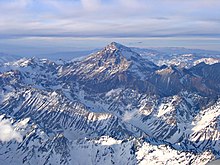
The geography of the western Americas is dominated by theAmerican Cordillera,with theAndesrunning along the west coast of South America[61]and theRocky Mountainsand otherNorth American Cordilleraranges running along the western side of North America.[62]The 2,300-kilometer-long (1,400 mi)Appalachian Mountainsrun along the east coast of North America fromAlabamatoNewfoundland.[63]North of the Appalachians, theArctic Cordilleraruns along the eastern coast of Canada.[64]
The largest mountain ranges are theAndesandRocky Mountains.TheSierra Nevadaand theCascade Rangereach similar altitudes as theRocky Mountains,but are significantly smaller. In North America, the greatest number offourteenersare in the United States, and more specifically in the US state ofColorado.The highest peaks of the Americas are located in theAndes,withAconcaguaofArgentinabeing the highest; in North AmericaDenali(Mount McKinley) in the US state ofAlaskais the tallest.
Between its coastal mountain ranges, North America has vast flat areas. TheInterior Plainsspread over much of the continent, with low relief.[65]TheCanadian Shieldcovers almost 5 million km2of North America and is generally quite flat.[66]Similarly, the north-east of South America is covered by the flatAmazon basin.[67]TheBrazilian Highlandson the east coast are fairly smooth but show some variations in landform, while farther south theGran ChacoandPampasare broadlowlands.[68]
Climate

The climate of the Americas varies significantly from region to region.Tropical rainforest climateoccurs in the latitudes of theAmazon,Americancloud forests,southeastern Florida andDarién Gap.In theRocky MountainsandAndes,dry and continental climates are observed. Often the higher altitudes of these mountains are snow-capped.
Southeastern North America is well known for its occurrence oftornadoesandhurricanes,of which the vast majority of tornadoes occur in the United States'Tornado Alley,[69]as well as in the southerlyDixie Alleyin the North American late-winter and early spring seasons. Often parts of the Caribbean are exposed to the violent effects of hurricanes. These weather systems are formed by the collision of dry, cool air from Canada and wet, warm air from the Atlantic.
Hydrology
With coastal mountains and interior plains, the Americas have several largeriver basinsthat drain the continents. The largest river basin in North America is that of theMississippi,covering the second largestwatershedon the planet.[70]The Mississippi-Missouri river system drains most of 31 states of the United States, most of theGreat Plains,and large areas between the Rocky and Appalachian mountains. This river is thefourth longest in the worldandtenth most powerful in the world.
In North America, to the east of theAppalachian Mountains,there are no major rivers but rather a series of rivers and streams that flow east with their terminus in the Atlantic Ocean, such as theHudson River,Saint John River,andSavannah River.A similar instance arises with central Canadian rivers that drain intoHudson Bay;the largest being theChurchill River.On the west coast of North America, the main rivers are theColorado River,Columbia River,Yukon River,Fraser River,andSacramento River.
The Colorado River drains much of theSouthern Rockiesand parts of theBasin and Range Province.The river flows approximately 1,450 miles (2,330 km) into theGulf of California,[71]during which over time it has carved out natural phenomena such as theGrand Canyonand created phenomena such as theSalton Sea.The Columbia is a large river, 1,243 miles (2,000 km) long, in central western North America and is the most powerful river on the West Coast of the Americas. In the far northwest of North America, the Yukon drains much of the Alaskan peninsula and flows 1,980 miles (3,190 km)[72]from parts of Yukon and the Northwest Territory to the Pacific. Draining to the Arctic Ocean of Canada, theMackenzie Riverdrains waters from the Arctic Great Lakes of Arctic Canada, as opposed to the Saint-Lawrence River that drains the Great Lakes of Southern Canada into the Atlantic Ocean. The Mackenzie River is the largest in Canada and drains 1,805,200 square kilometers (697,000 sq mi).[73]
The largest river basin in South America is that of theAmazon,which has the highest volume flow of any river on Earth.[74]The second largest watershed of South America is that of theParaná River,which covers about 2.5 million km2.[75]
Ecology
North America and South America began to develop a shared population of flora and fauna around 2.5 million years ago, whencontinental driftbrought the two continents into contact via theIsthmus of Panama.Initially, the exchange of biota was roughly equal, with North American genera migrating into South America in about the same proportions as South American genera migrated into North America. This exchange is known as theGreat American Interchange.The exchange became lopsided after roughly a million years, with the total spread of South American genera into North America far more limited in scope than the spread of North American genera into South America.[76]
Countries and territories
There are 35 sovereign states in the Americas, as well as anautonomous countryofDenmark,threeoverseas departmentsofFrance,threeoverseas collectivitiesof France,[77]and one uninhabited territory of France, eightoverseas territoriesof theUnited Kingdom,threeconstituent countriesof theNetherlands,threepublic bodiesof the Netherlands, twounincorporated territoriesof theUnited States,and one uninhabited territory of the United States.[78]
| Country or territory | Total area (km2)[79] |
Population [note 1] |
Pop. density (per km2) |
Common languages (official inbold) |
Capital |
|---|---|---|---|---|---|
| 91 | 13,452 | 164.8 | English | The Valley | |
| 442 | 86,295 | 199.1 | Creole,[80]English | St. John's | |
| 2,766,890 | 42,669,500 | 14.3 | Spanish | Buenos Aires | |
| 180 | 101,484 | 594.4 | Papiamentu,Spanish,[81]Dutch | Oranjestad | |
| 13,943 | 351,461 | 24.5 | Creole,[82]English | Nassau | |
| Bajo Nuevo Bank(United States / Colombia / Jamaica) | 100[83] | 0[84] | 0.0 | Uninhabited | N/A |
| 430 | 285,000 | 595.3 | Bajan,[85]English | Bridgetown | |
| 22,966 | 349,728 | 13.4 | Spanish,Kriol,English[86] | Belmopan | |
| 54 | 64,237 | 1,203.7 | English | Hamilton | |
| 1,098,580 | 10,027,254 | 8.4 | Spanishand36 indigenous languages | La PazandSucre[87] | |
| 294 | 12,093 | 41.1 | Papiamentu,Spanish,Dutch[88] | Kralendijk | |
| 8,514,877 | 203,106,000 | 23.6 | Portuguese | Brasília | |
| 151 | 29,537 | 152.3 | English | Road Town | |
| 9,984,670 | 37,411,592 | 3.8 | English,French | Ottawa | |
| 264 | 81,546 | 212.1 | English | George Town | |
| 756,950 | 17,773,000 | 22 | Spanish | Santiago | |
| 6[83] | 0[84] | 0.0 | Uninhabited | N/A | |
| 1,138,910 | 47,757,000 | 40 | Spanish | Bogotá | |
| 51,100 | 4,667,096 | 89.6 | Spanish | San José | |
| 109,886 | 11,167,325 | 102.0 | Spanish | Havana | |
| 444 | 150,563 | 317.1 | Papiamentu,Dutch[88] | Willemstad | |
| 751 | 71,293 | 89.2 | French Patois,English[90] | Roseau | |
| 48,671 | 10,378,267 | 207.3 | Spanish | Santo Domingo | |
| 283,560 | 15,819,400 | 53.8 | Spanish,Quechua[91] | Quito | |
| 21,041 | 6,401,240 | 293.0 | Spanish | San Salvador | |
| 12,173 | 3,000 | 0.26 | English | Stanley | |
| 342 | 2,155 | 2.4 | Spanish | N/A | |
| 91,000 | 237,549 | 2.7 | French | Cayenne | |
| 2,166,086 | 56,483 | 0.026 | Greenlandic,Danish | Nuuk | |
| 344 | 103,328 | 302.3 | English | St. George's | |
| 1,628 | 405,739 | 246.7 | French | Basse-Terre | |
| 108,889 | 15,806,675 | 128.8 | Spanish,Garifuna and 23 Mayan languages | Guatemala City | |
| 214,999 | 784,894 | 3.5 | English | Georgetown | |
| 27,750 | 10,745,665 | 361.5 | Creole,French | Port-au-Prince | |
| 112,492 | 8,555,072 | 66.4 | Spanish | Tegucigalpa | |
| 10,991 | 2,717,991 | 247.4 | Patois,English | Kingston | |
| 1,128 | 392,291 | 352.6 | Patois,[93]French | Fort-de-France | |
| 1,964,375 | 119,713,203 | 57.1 | Spanish, 68 indigenous languages | Mexico City | |
| 102 | 4,922 | 58.8 | Creole English,English[94] | Plymouth;Brades[95] | |
| Navassa Island(United States / Haiti) | 5[83] | 0[84] | 0.0 | Uninhabited | Lulu Town |
| 130,373 | 6,071,045 | 44.1 | Spanish | Managua | |
| 75,417 | 3,405,813 | 45.8 | Spanish | Panama City | |
| 406,750 | 6,783,374 | 15.6 | Guaraní,Spanish | Asunción | |
| 1,285,220 | 30,814,175 | 22 | Spanish, Quechua, and other indigenous languages | Lima | |
| 8,870 | 3,615,086 | 448.9 | Spanish,English | San Juan | |
| 13 | 1,537[96] | 118.2 | English,Dutch | The Bottom | |
| 21[83] | 8,938[84] | 354.7 | French | Gustavia | |
| 261 | 55,000 | 199.2 | English | Basseterre | |
| 539 | 180,000 | 319.1 | English,French Creole | Castries | |
| 54[83] | 36,979 | 552.2 | French | Marigot | |
| 242 | 6,081 | 24.8 | French | Saint-Pierre | |
| 389 | 109,000 | 280.2 | English | Kingstown | |
| Serranilla Bank(United States / Colombia / Honduras) | 100[83] | 0[84] | 0.0 | Uninhabited | N/A |
| 21 | 2,739[96] | 130.4 | Dutch,English | Oranjestad | |
| 34 | 37,429 | 1,176.7 | English,Spanish,Dutch | Philipsburg | |
South Sandwich Islands(United Kingdom)[97] |
3,093 | 20 | 0.01 | English | King Edward Point |
| 163,270 | 534,189 | 3 | Dutchand others[98] | Paramaribo | |
| 5,130 | 1,328,019 | 261.0 | English | Port of Spain | |
| 948 | 31,458 | 34.8 | Creole English,English[99] | Cockburn Town | |
| 9,629,091 | 320,206,000 | 34.2 | English, Spanish | Washington, D.C. | |
| 347 | 106,405 | 317.0 | English | Charlotte Amalie | |
| 176,220 | 3,286,314 | 19.4 | Spanish | Montevideo | |
| 916,445 | 30,206,307 | 30.2 | Spanish and 40 indigenous languages | Caracas | |
| Total | 42,320,985 | 973,186,925 | 21.9 |
Demography
Population
In 2021 the total population of the Americas was about 1.03 billion people, divided as follows:
- North America: 596.6 million (includes Central America and theCaribbean)
- South America: 434.3 million
Largest urban centers
There are three urban centers that each hold titles for being the largest population area based on the three main demographic concepts:[100]
- A city proper is the locality with legally fixed boundaries and an administratively recognized urban status that is usually characterized by some form of local government.[101][102][103][104][105]
- An urban area is characterized by higher population density and vast human features in comparison to areas surrounding it. Urban areas may be cities, towns or conurbations, but the term is not commonly extended to rural settlements such as villages and hamlets. Urban areas are created and further developed by the process of urbanization and do not include large swaths of rural land, as do metropolitan areas.[citation needed]
- Unlike an urban area, a metropolitan area includes not only the urban area, but also satellite citiesplus intervening rural landthat is socio-economically connected to the urban core city, typically by employment ties through commuting, with the urban core city being the primary labor market.[citation needed]
In accordance with these definitions, the three largest population centers in the Americas are:Mexico City,anchor to the largest metropolitan area in the Americas; New York City, anchor to the largest urban area in the Americas; and São Paulo, the largest city proper in the Americas. All three cities maintainAlphaclassification and large scale influence.
- Urban centers within the Americas
-
Mexico City– largest metropolitan area in the Americas, with a population of 22,300,000 in 2017
-
São Paulo– largest city in the Americas, with a population of 12,038,175 (city) in 2016
-
New York City– largest urban area in the Americas, with a population of 18,351,295 in 2010
| Country | City | City Population | Metro Area Population |
|---|---|---|---|
| Mexico | Mexico City | 8,864,000 | 22,300,000[106] |
| Brazil | São Paulo | 12,038,175 | 21,742,939[107] |
| United States | New York City | 8,405,837[108] | 19,949,502[109] |
| Argentina | Buenos Aires | 2,891,082[14] | 15,594,428[14] |
| United States | Los Angeles | 3,928,864[110] | 13,131,431[111] |
Ethnology

The population of the Americas is made up of the descendants of four largeethnic groupsand their combinations.
- TheIndigenous peoples of the Americas,being Amerindians andInuit-Yupik-Unangan.
- Those of European ancestry, mainly Spanish, English, Irish,Portuguese,German,Italian,French,andDutch.
- Those ofAfricanancestry, mainly of West African descent.
- Asians,that is, those ofEast Asian,South Asian,andSoutheast Asianancestry.
- Mestizos(Métis peoplein Canada), those of mixed European and Amerindian ancestry.
- Mulattoes,people of mixed African and European ancestry.
- Zambos(Spanish) or Cafuzos (Portuguese), those of mixed African and Indigenous ancestry.
The majority of the population lives inLatin America,named for its predominant cultures, rooted inLatin Europe(including the two dominant languages, Spanish andPortuguese,bothRomance languages), more specifically in theIberiannations ofPortugaland Spain (hence the use of the termIbero-Americaas a synonym). Latin America is typically contrasted withAnglo-America,where English, aGermanic language,is prevalent, and which comprises Canada (with the exception ofFrancophone Canadarooted in Latin Europe [France]—seeQuebecandAcadia) and the United States. Both countries are located in North America, with cultures deriving predominantly fromBritishand otherGermanicroots.
Black population

The transatlantic slave trade brought millions of Africans to the territories of the Americas under the colonial rule of European powers. In South America,Portugalplayed a significant role in the trafficking of enslaved Africans, with estimates suggesting that around 40% of all Africans forcibly brought to the Americas were taken to Brazil alone, to work primarily in sugar cane plantations, mining, and agricultural endeavors.[112]In North America, theBritish Empirewas heavily involved in the transatlantic slave trade, with the establishment of colonies such as Virginia, where enslaved Africans were primarily used as labor in tobacco plantations and later in other agricultural and domestic sectors. This system perpetuated for centuries, shaping the socio-economic landscape of all nations of the hemisphere.
After theHaitian Revolutionled byJean-Jacques Dessalines,which started in 1791 and was the only successful slave revolt in history, the world's first black republic was established. It started with the massacre of the white population, between 3,000 and 5,000 white men and women of all ages were killed. Dessalines declared:
Oui, j’ai sauvé mon pays, j’ai vengé l’Amérique.
Yes, I have saved my country – I have avenged America.
— Dessalines, first president of the Republic of Haiti, 1804[113][114]
Religion
The most prevalent faiths in the Americas are as follows:
- Christianity (86 percent)[115]
- Roman Catholicism: Practiced by 69 percent[116]of the Latin American population (61 percent[116]in Brazil whose Roman Catholic population of 134 million[117]is the greatest of any nation's), approximately 24 percent of the United States' population[118]and about 39 percent of Canada's.[119]
- Protestantism: Practiced mostly in the United States, where half of the population are Protestant, Canada, with slightly more than a quarter of the population, and Greenland; there is a growing contingent ofEvangelicalandPentecostalmovements in predominantly Catholic Latin America.[120]
- Eastern Orthodoxy:Found mostly in the United States (1 percent) and Canada; this Christian group is growing faster than many other Christian groups in Canada and now represents roughly 3 percent of the Canadian population.[119]
- Non-denominational Christiansand other Christians (some 1,000 different Christian denominations and sects practiced in the Americas).
- Irreligion:About 12 percent, including atheists and agnostics, as well as those who profess some form of spirituality but do not identify themselves as members of any organized religion.
- Islam: Together, Muslims constitute about 1 percent of the North American population and 0.3 percent of all Latin Americans. It is practiced by 3 percent[119]of Canadians and 0.6 percent of the U.S. population.[118]Argentinahas the largest Muslim population in Latin America with up to 600,000 persons, or 1.5 percent of the population.[121]
- Judaism (practiced by 2 percent of North Americans—approximately 2.5 percent of the U.S. population and 1.2 percent of Canadians[122]—and 0.23 percent of Latin Americans—Argentina has the largest Jewish population in Latin America with 200,000 members)[123]
Other faiths includeBuddhism;Hinduism;Sikhism;Baháʼí Faith;a wide variety of indigenous religions, many of which can be categorized asanimistic;new agereligions and manyAfricanand African-derived religions.Syncreticfaiths can also be found throughout the Americas.
| Country | Christians | Catholics | Protestants | None/Atheists/Agnostics | Others |
|---|---|---|---|---|---|
| Argentina[124] | 86.2% | 76.5% | 9.7% | 11.3% | 2.5% |
| Bolivia | 95.3% | 73.7% | 21.6% | 3.7% | 1.0% |
| Brazil[125] | 86.8% | 64.6% | 22.2% | 8.4% | 4.8% |
| Canada[119] | 62.6% | 38.7% | 23.9% | 28.5% | 8.9% |
| Chile[126] | 76.0% | 60.0% | 16.0% | 21.0% | 3.0% |
| Colombia[127] | 93.9% | 80.3% | 13.6% | 5.2% | 1.7% |
| Costa Rica[128] | 84.3% | 70.5% | 13.8% | 11.3% | 4.3% |
| Dominican Republic[129] | 87.1% | 68.3% | 18.8% | 10.6% | 2.2% |
| Ecuador[130] | 95.6% | 87.8% | 7.7% | 3.5% | 1.0% |
| El Salvador[131] | 75.5% | 45.8% | 29.7% | 24.3% | 1.2% |
| Guatemala[132] | 79.3% | 47.6% | 31.7% | 18.3% | 2.4% |
| Honduras[133] | 83.0% | 47.9% | 35.1% | 14.3% | 2.7% |
| Mexico[134] | 92.2% | 82.7% | 8.7% | 4.9% | 2.9% |
| Nicaragua[135] | 81.1% | 54.3% | 26.8% | 16.8% | 2.1% |
| Panama | 90.0% | 75.0% | 15.0% | 7.0% | 3.0% |
| Paraguay | 96.8% | 90.4% | 6.4% | 1.4% | 1.8% |
| Peru[136] | 96.7% | 81.3% | 12.5% | 1.9% | 1.4% |
| United States[137] | 79.9% | 25.9% | 54.0% | 15.2% | 5.0% |
| Uruguay[138] | 58.2% | 47.1% | 11.1% | 40.4% | 1.5% |
| Venezuela[139] | 89.0% | 72.0% | 17.0% | 8.0% | 3.0% |
Languages
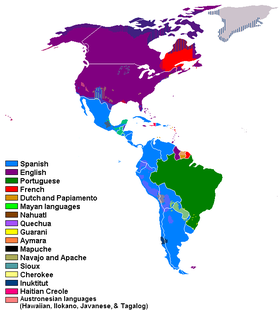
Variouslanguagesare spoken in the Americas. Some are of European origin, others are spoken by indigenous peoples or are the mixture of various languages like the different creoles.[128]
The most widely spokenfirst languagein the Americas isSpanish,followed byEnglishandPortuguese.[140]The dominant language ofLatin Americais Spanish, though the most populous nation in Latin America,Brazil,speaksPortuguese.Small enclaves ofFrench-,Dutch- and English-speaking regions also exist in Latin America, notably inFrench Guiana,Suriname,andBelizeandGuyanarespectively.Haitian Creoleis dominant in the nation ofHaiti,where French is also spoken.Native languagesare more prominent in Latin America than inAnglo-America,withNahuatl,Quechua,Aymara,andGuaranías the most common. Various other native languages are spoken with less frequency across both Anglo-America and Latin America.Creole languagesother than Haitian Creole are also spoken in parts of Latin America.
The dominant language of Anglo-America is English. French is also official inCanada,where it is the predominant language inQuebecand an official language inNew Brunswickalong with English. It is also an important language inLouisiana,and in parts ofNew Hampshire,Maine,andVermont.Spanish has kept an ongoing presence in theSouthwestern United States,which formed part of theViceroyalty of New Spain,especially inCaliforniaandNew Mexico,wherea distinct variety of Spanishspoken since the 17th century has survived. It has more recently become widely spoken in other parts of theUnited Statesbecause of heavy immigration from Latin America. High levels of immigration in general have brought great linguistic diversity to Anglo-America, with over 300 languages known to be spoken in the United States alone, but most languages are spoken only in small enclaves and by relatively small immigrant groups.
The nations of Guyana, Suriname, and Belize are generally considered[by whom?]not to fall into either Anglo-America or Latin America because of their language differences from Latin America, geographic differences from Anglo-America, and cultural and historical differences from both regions; English is the primary language of Guyana and Belize, and Dutch is the primary language of Suriname.
Most of the non-native languages have, to different degrees, evolved differently from the mother country, but are usually still mutually intelligible. Some have combined, however, which has even resulted in completely new languages, such asPapiamento,which is a combination of Portuguese, Spanish, Dutch (representing the respective colonizers), nativeArawak,variousAfrican languages,and, more recently English. Thelingua francaPortuñol,a mixture of Portuguese and Spanish, is spoken in the border regions of Brazil and neighboring Spanish-speaking countries.[141]More specifically,Riverense Portuñolis spoken by around 100,000 people in the border regions of Brazil andUruguay.Because ofimmigration,there are many communities where other languages are spoken from all parts of the world, especially in the United States, Brazil,Argentina,Canada,Chile,Costa Rica,and Uruguay—very important destinations for immigrants.[142][143][144]
Terminology
English
Speakers of Englishgenerally refer to thelandmassesof North America and South America asthe Americas,theWestern Hemisphere,or theNew World.[6]The adjectiveAmericanmay be used to indicate something pertaining to the Americas,[2]but this term is primarily used in English to indicate something pertaining to the United States.[2][145][146]Some non-ambiguous alternatives exist, such as the adjectivePan-American,[147]orNew Worlderas a demonym for a resident of the closely relatedNew World.[4]Use ofAmericain the hemispherical sense is sometimes retained, or can occur when translated from other languages.[148]For example, theAssociation of National Olympic Committees(ANOC) in Paris maintains a single continental association for "America", represented by one of the fiveOlympic rings.[149]
American essayistH.L. Menckensaid, "The Latin-Americans use Norteamericano in formal writing, but, save in Panama, prefer nicknames in colloquial speech."[150]To avoid "American" one can use constructed terms in their languages derived from "United States" or even "North America".[146][151][152]In Canada, its southern neighbor is often referred to as "the United States", "the U.S.A.", or (informally) "the States", while U.S. citizens are generally referred to as "Americans".[146]Most Canadians resent being referred to as "Americans".[146]
Spanish
In Spanish,Américais a single continent composed of thesubcontinentsofAmérica del SurandAmérica del Norte,theland bridgeofAmérica Central,and the islands of theAntillas.Americanooramericanain Spanish refers to a person fromAméricain a similar way that in whicheuropeooreuropearefers to a person fromEuropa.The termssudamericano/a,centroamericano/a,antillano/aandnorteamericano/acan be used to more specifically refer to the location where a person may live.
Citizens of the United States of America are normally referred to by the termestadounidense(rough literal translation: "United Statesian") instead ofamericanooramericanawhich is discouraged,[153][154]and the country's name itself is officially translated asEstados Unidos de América(United States of America), commonly abbreviated asEstados Unidos(EEUU).[154]Also, the termnorteamericano(North American) may refer to a citizen of the United States. This term is primarily used to refer to citizens of the United States, and less commonly to those of other North American countries.[153]
Portuguese
In Portuguese,América[155]is a single continent composed ofAmérica do Sul(South America),América Central(Central America) andAmérica do Norte(North America).[156]It can be ambiguous, asAméricacan be used to refer to the United States of America, but is avoided in print and formal environments.[157][158]
French
In French the wordaméricainmay be used for things relating to the Americas; however, similar to English, it is most often used for things relating to the United States, with the termétats-uniensometimes used for clarity.Panaméricainmay be used as an adjective to refer to the Americas without ambiguity.[159]French speakers may use the nounAmériqueto refer to the whole landmass as one continent, or two continents,Amérique du NordandAmérique du Sud.In French,Amériqueis seldom used to refer to the United States, leading to some ambiguity when it is. Similar to English usage,les Amériquesordes Amériquesis used to refer unambiguously to the Americas.
Dutch
In Dutch, the wordAmerikamostly refers to the United States.[160][161]Although the United States is equally often referred to asde Verenigde Staten( "the United States" ) orde VS( "the US" ),Amerikarelatively rarely refers to the Americas, but it is the only commonly used Dutch word for the Americas. This often leads to ambiguity; and to stress that something concerns the Americas as a whole, Dutch uses a combination, namelyNoord- en Zuid-Amerika(North and South America).
Latin America and Central America are generally referred to asLatijns AmerikaandMidden-Amerikarespectively.
The adjectiveAmerikaansis most often used for things or people relating to the United States. There are no alternative words to distinguish between things relating to the United States or to the Americas. Dutch uses the local alternative for things relating to elsewhere in the Americas, such asArgentijnsforArgentine,etc.
Multinational organizations
The following is a list of multinational organizations in the Americas.
- Alliance for Progress
- American Capital of Culture
- Andean Community of Nations
- Association of Caribbean States
- Bank of the South
- Bolivarian Alternative for the Americas
- Caribbean Community
- CARICOM Single Market and Economy
- Central American Common Market
- Central American Parliament
- Community of Latin American and Caribbean States
- Contadora Group
- Free Trade Area of the Americas
- Latin American Free Trade Agreement
- Latin American Parliamentor Parlatino
- Mercosuror Mercosul
- North Atlantic Treaty Organization
- Organization of American States
- Organisation of Eastern Caribbean States
- Organization of Ibero-American States
- Pacific Alliance
- Pan American Sports Organization
- Regional Security System
- Rio Group
- School of the Americas
- Summit of the Americas
- Union of South American Nations
- United States–Mexico–Canada Agreement
- YOA Orchestra of the Americas
Economy
| Rank | Country | GDP(nominal, peak year) millions ofUSD[162] |
Peak year |
|---|---|---|---|
| 1 | 28,781,083 | 2024 | |
| 2 | 2,616,156 | 2011 | |
| 3 | 2,242,182 | 2024 | |
| 4 | 2,017,025 | 2024 | |
| 5 | 654,892 | 2023 | |
| 6 | 545,218 | 2021 | |
| 7 | 482,359 | 2014 | |
| 8 | 386,076 | 2024 | |
| 9 | 335,658 | 2023 | |
| 10 | 282,458 | 2024 |
| Rank | Country | GDP(PPP, peak year) millions ofUSD |
Peak year |
|---|---|---|---|
| 1 | 28,781,083 | 2024 | |
| 2 | 4,454,930 | 2023 | |
| 3 | 3,434,224 | 2024 | |
| 4 | 2,472,227 | 2024 | |
| 5 | 1,369,904 | 2023 | |
| 6 | 1,122,332 | 2023 | |
| 7 | 653,361 | 2023 | |
| 8 | 574,288 | 2023 | |
| 9 | 561,498 | 2013 | |
| 10 | 293,365 | 2024 |
In exports and imports, in 2020, the United States was the world's second largest exporter (US$1.64 trillion) and the largest importer (US$2.56 trillion). Mexico was the tenth largest exporter and importer. Canada was the twelfth largest exporter and importer. Brazil was the 24th largest exporter and the 28th largest importer. Chile was the 45th largest exporter and the 47th largest importer. Argentina was the 46th largest exporter and the 52nd largest importer. Colombia was the 54th largest exporter and the 51st largest importer; among others.[167][168][169]
Theagricultureof the continent is very strong and varied. Countries such asUnited States,Brazil,Canada,Mexico,andArgentinaare among the largest agricultural producers on the planet. In 2019, the continent dominated the world production ofsoy(almost 90% of the world total, with Brazil, the United States, Argentina, Paraguay, Canada and Bolivia among the 10 largest on the planet),sugarcane(about 55% of the world total, with Brazil, Mexico, the United States, and Guatemala among the 10 largest on the planet),coffee(about 55% of the world total, with Brazil, Colombia, Honduras, Peru, and Guatemala among the 10 largest on the planet) andmaize(about 48% of the world total, with the United States, Brazil, Argentina, and Mexico among the 10 largest on the planet). The continent also produces almost 40% of world'sorange(with Brazil, the United States, and Mexico among the top 10 producers), about 37% of world'spineapple(with Costa Rica, Brazil, Mexico, and Colombia among the 10 largest producers), about 35% of world'slemon(with Mexico, Argentina, Brazil, and the United States among the 10 largest producers) and about 30% of world'scotton(with the United States, Brazil, Mexico and Argentina among the top 10 producers), among several other products.[170]
Inlivestock,America also has giant productions. In 2018, the continent produced around 45% of the world'sbeef(with the United States, Brazil, Argentina, Mexico, and Canada among the world's 10 largest producers); about 36% of the world'schicken meat(with the United States, Brazil, and Mexico among the world's 10 largest producers), and about 28% of the world'scow's milk(with the United States and Brazil among the 10 largest producers in the world), among other products.[170]
In industrial terms, theWorld Banklists the top producing countries each year, based on the total value of production. According to the 2019 list, the United States has the second most valuable industry in the world (US$2.3 trillion), Mexico has the 12th most valuable industry in the world (US$217.8 billion), Brazil has the 13th most valuable industry in the world (US$173.6 billion), Canada has the 15th most valuable industry in the world (US$151.7 billion), Venezuela the 30th largest (US$58.2 billion, but depends on the oil to obtain this amount), Argentina was the 31st largest (US$57.7 billion), Colombia the 46th largest (US$35.4 billion), Peru the 50th largest ($28.7 billion), and Chile the 51st largest (US$28.3 billion), among others.[171]
In the production ofoil,the continent had 8 of the 30 largest world producers in 2020: United States (1st), Canada (4th), Brazil (8th), Mexico (14th), Colombia (20th), Venezuela (26th), Ecuador (27th), and Argentina (28th).[172]
In the production ofnatural gas,the continent had 8 of the 32 largest world producers in 2015: United States (1st), Canada (5th), Argentina (18th), Trinidad and Tobago (20th), Mexico (21st), Venezuela (28th), Bolivia (31st), and Brazil (32nd).[173][174]
In the production ofcoal,the continent had 5 of the 30 largest world producers in 2018: United States (3rd), Colombia (12th), Canada (13th), Mexico (24th), and Brazil (27th).[175]
In the production ofvehicles,the continent had 5 of the 30 largest world producers in 2019: United States (2nd), Mexico (7th), Brazil (9th), Canada (12th), and Argentina (28th).[176]
In the production ofsteel,the continent had 5 of the 31 largest world producers in 2019: United States (4th), Brazil (9th), Mexico (15th), Canada (18th), and Argentina (31st).[177][178]
Inmining,the continent has large productions ofgold(mainly in the United States, Canada, Peru, Mexico, Brazil, and Argentina);[179]silver(mainly in Mexico, Peru, Chile, Bolivia, Argentina, and the United States);[180]copper(mainly in Chile, Peru, the United States, Mexico, and Brazil);[181]platinum(Canada and the United States);[182]iron ore(Brazil, Canada, the United States, Peru, and Chile);[183]zinc(Peru, the United States, Mexico, Bolivia, Canada, and Brazil);[184]molybdenum(Chile, Peru, Mexico, Canada, and the United States);[185]lithium(Chile, Argentina, Brazil, and Canada);[186]lead(Peru, the United States, Mexico, and Bolivia);[187]bauxite(Brazil, Jamaica, Canada, and the United States);[188]tin(Peru, Bolivia, and Brazil);[189]manganese(Brazil and Mexico);[190]antimony(Bolivia, Mexico, Guatemala, Canada, and Ecuador);[191]nickel(Canada, Brazil, Dominican Republic, Cuba, and the United States);[192]niobium(Brazil and Canada);[193]rhenium(Chile and the United States);[194]andiodine(Chile),[195]among others.
Dominica,Panama,and theDominican Republichave the fastest-growing economy in the Americas according to theInternational Monetary Fund(IMF),[196]16, five to seven countries in the southern part of the Americas had weakening economies in decline, compared to only three countries in the northern part of the Americas.[197][198]Haiti has the lowest GDP per capita in the Americas, although its economy was growing slightly as of 2016[update].[197][198]
See also
- Amerrisque Mountains
- Abya Yala– indigenous name for the North and South American continents
- British North America
- Columbia (name)
- Ethnic groups in Central America
- French America
- Indigenous Peoples' Day
- La Merika
- List of conflicts in the Americas
- List of former sovereign states
- List of oldest buildings in the Americas
- Monarchies in the Americas
- New Sweden
- Pan-Americanism
- Pan-American Highway
- Pan American Games
- Personification of the Americas
- Southern Cone
Notes
- ^Seelist of countries by populationfor references.
- ^Includes the states of Hawaii and Alaska, which are both separated from theUS mainland,with Hawaii distant from the North American landmass in the Pacific Ocean and therefore more commonly associated with the other territories of Oceania, while Alaska is located betweenCanadaandAsia(Russia).
References
- ^"Population".United Nations.RetrievedJuly 25,2021.
- ^abc"American".Oxford English Dictionary(Online ed.).Oxford University Press.(Subscription orparticipating institution membershiprequired.)
- ^"Pan-American".Oxford English Dictionary(Online ed.).Oxford University Press.(Subscription orparticipating institution membershiprequired.)
- ^ab"New Worlder".Oxford English Dictionary(Online ed.).Oxford University Press.(Subscription orparticipating institution membershiprequired.)
- ^abcd"America."The Oxford Companion to the English Language(ISBN0-19-214183-X). McArthur, Tom, ed., 1992. New York: Oxford University Press, p. 33: "[16c: from the feminine ofAmericus,the Latinized first name of the explorer Amerigo Vespucci (1454–1512). The nameAmericafirst appeared on a map in 1507 by the German cartographer Martin Waldseemüller, referring to the area now called Brazil]. Since the 16c, a name of the western hemisphere, often in the pluralAmericasand more or less synonymous withthe New World.Since the 18c, a name of the United States of America. The second sense is now primary in English:... However, the term is open to uncertainties:... "
- ^abBurchfield, R. W. 2004.Fowler's Modern English Usage.(ISBN0-19-861021-1) Oxford, UK: Oxford University Press; p. 48.
- ^"America".Oxford Dictionary.
- ^abWebster's New World College Dictionary,2010 by Wiley Publishing, Inc., Cleveland, Ohio.
- ^Merriam Webster dictionary.Merriam-Webster, Incorporated. 2013.RetrievedMarch 23,2016.
- ^"continent n. 5. a." (1989)Oxford English Dictionary,2nd edition.Oxford University Press;"continent1n. "(2006)TheConcise Oxford English Dictionary,11th edition revised. (Ed.) Catherine Soanes and Angus Stevenson. Oxford University Press; "continent1n. "(2005)TheNew Oxford American Dictionary,2nd edition. (Ed.)Erin McKean.Oxford University Press; "continent [2, n] 4 a" (1996)Webster's Third New International Dictionary, Unabridged.ProQuestInformation and Learning; "continent" (2007)Encyclopædia Britannica.Retrieved January 14, 2007, from Encyclopædia Britannica Online.
- ^"Leif Erikson (11th century)".BBC.RetrievedNovember 20,2011.
- ^Kamen, Henry.Spain's Road to Empire: The Making of a World Power, 1492–1763.
- ^Taylor, Alan(2001).American Colonies.New York: Penguin Books.ISBN9780142002100.
- ^abc"Censo 2010. Resultados provisionales: cuadros y grá"(in Spanish). Archived fromthe originalon December 20, 2010.RetrievedFebruary 25,2011.
- ^"Cartographer Put 'America' on the Map 500 years Ago".USA Today.Washington, D.C. Associated Press. April 24, 2007.RetrievedNovember 30,2008.
- ^Lawless, Jill (November 7, 2017)."Oldest map to use word 'America' up for sale".News and Record.Associated Press.RetrievedJune 5,2019.
- ^"The Map That Named America (September 2003) – Library of Congress Information Bulletin".Loc.gov.
- ^Toby Lester, "Putting America on the Map",Smithsonian,40:9 (December 2009)
- ^"The Myth of Continents: A Critique of Metageography (Chapter 1)".University of California Press.RetrievedAugust 14,2018.
- ^See for example:america – Definition from the Merriam-Webster Online Dictionary.Retrieved on January 27, 2008; "dictionary.reference.com america".Dictionary.com. The American Heritage Dictionary of the English Language, Fourth Edition. Houghton Mifflin Company, 2004. Accessed: January 27, 2008.
- ^Marjorie Fee and Janice MacAlpine,Oxford Guide to Canadian English Usage(2008) page 36 says "In Canada,Americanis used almost exclusively in reference to the United States and its citizens. "Others, includingThe New Zealand Oxford Dictionary,The Canadian Oxford Dictionary,The Australian Oxford DictionaryandThe Concise Oxford English Dictionaryall specify both the Americas and the United States in their definition of "American".
- ^Mann, Charles C.(2005).1491: New Revelations of the Americas Before Columbus.New York:Knopf.ISBN978-1-4000-4006-3.OCLC56632601.
- ^Burenhult, Göran (2000).Die ersten Menschen.Weltbild Verlag.ISBN3-8289-0741-5.
- ^"Introduction".Government of Canada.Parks Canada. 2009. Archived fromthe originalon April 24, 2011.RetrievedJanuary 9,2010.
Canada's oldest known home is a cave in Yukon occupied not 12,000 years ago like the U.S. sites, but at least 20,000 years ago
- ^"Pleistocene Archaeology of the Old Crow Flats".Vuntut National Park of Canada. 2008. Archived fromthe originalon October 22, 2008.RetrievedJanuary 10,2010.
However, despite the lack of this conclusive and widespread evidence, there are suggestions of human occupation in the northern Yukon about 24,000 years ago, and hints of the presence of humans in the Old Crow Basin as far back as about 40,000 years ago.
- ^ab"Journey of mankind".Brad Shaw Foundation.RetrievedNovember 17,2009.
- ^ab"Atlas of the Human Journey-The Genographic Project".National Geographic Society. 1996–2008. Archived fromthe originalon May 1, 2011.RetrievedOctober 6,2009.
- ^Bonatto, SL; Salzano, FM (1997)."A single and early migration for the peopling of the Americas supported by mitochondrial DNA sequence data".Proceedings of the National Academy of Sciences of the United States of America.94(5). National Academy of Sciences: 1866–71.Bibcode:1997PNAS...94.1866B.doi:10.1073/pnas.94.5.1866.ISSN0027-8424.PMC20009.PMID9050871.
- ^Wells, Spencer; Read, Mark (2002).The Journey of Man – A Genetic Odyssey(Digitised online by Google books).Random House. pp. 138–140.ISBN0-8129-7146-9.RetrievedNovember 21,2009.
- ^Fitzhugh, Drs. William; Goddard, Ives; Ousley, Steve; Owsley, Doug; Stanford, Dennis."Paleoamerican".Smithsonian Institution Anthropology Outreach Office. Archived fromthe originalon January 5, 2009.RetrievedJanuary 15,2009.
- ^"The peopling of the Americas: Genetic ancestry influences health".Scientific American.RetrievedNovember 17,2009.
- ^Fladmark, K. R. (January 1979). "Alternate Migration Corridors for Early Man in North America".American Antiquity.44(1): 55–69.doi:10.2307/279189.JSTOR279189.S2CID162243347.
- ^"68 Responses to" Sea will rise 'to levels of last Ice Age' "".Center for Climate Systems Research, Columbia University.January 26, 2009.Archivedfrom the original on October 27, 2009.RetrievedNovember 17,2009.
- ^Ledford, Heidi (January 8, 2009)."Earliest Americans took two paths".Nature.doi:10.1038/news.2009.7.
- ^"Summary of knowledge on the subclades of Haplogroup Q".Genebase Systems. 2009. Archived fromthe originalon May 10, 2011.RetrievedNovember 22,2009.
- ^abMeltzer, David J. (May 27, 2009).First Peoples in a New World: Colonizing Ice Age America.University of California Press. p. 146.ISBN978-0-520-25052-9.
- ^Reich, David; et al. (August 16, 2012)."Reconstructing Native American population history".Nature.488(7411): 370–374.Bibcode:2012Natur.488..370R.doi:10.1038/nature11258.PMC3615710.PMID22801491.
- ^Lyovi, Anatole (1997).An introduction to the languages of the world.Oxford University Press. p. 309.ISBN0-19-508115-3.RetrievedMarch 25,2010.
- ^Mithun, Marianne (1990). "Studies of North American Indian Languages".Annual Review of Anthropology.19(1): 309–330.doi:10.1146/annurev.an.19.100190.001521.S2CID146205659.
- ^Vajda, Edward (2010)."A Siberian link with Na-Dene languages".Anthropological Papers of the University of Alaska.[dead link]
- ^Fagan, Brian M. (2005).Ancient North America: The Archaeology of a Continent(4 ed.). New York: Thames & Hudson Inc. pp. 390, p396.ISBN0-500-28148-3.
- ^abT. Kue Young; Peter Bjerregaard (June 28, 2008).Health Transitions in Arctic Populations.University of Toronto Press. p. 121.ISBN978-0-8020-9401-8.
- ^"Vinland".Canadian Museum of Civilization. Archived fromthe originalon November 10, 2010.
- ^Curran, James Watson (1939).Here was Vinland: The Great Lakes Region of America.Sault Ste. Marie, Ontario:Sault Daily Star.p. 207.
- ^"Lucas Vázquez de Ayllón".Britannica.January 2024.
- ^"The Spanish and New World Slavery · African Laborers for a New Empire: Iberia, Slavery, and the Atlantic World · Lowcountry Digital History Initiative".ldhi.library.cofc.edu.
- ^"Giovanni da Verrazzano".Britannica.January 2024.
- ^"John Cabot".Britannica.December 14, 2023.
- ^Thornton, Russell (1997)."Aboriginal North American Population and Rates of Decline, c.a. A.D. 1500–1900".Current Anthropology.38(2): 310–315.doi:10.1086/204615.JSTOR00113204.S2CID143901232.Archived fromthe originalon March 28, 2022.
- ^Crosby, Alfred W. (April 1976). "Virgin Soil Epidemics as a Factor in the Aboriginal Depopulation in America".William and Mary Quarterly.33(2): 289–299.doi:10.2307/1922166.JSTOR1922166.PMID11633588.S2CID44458578.
- ^Dobyns, Henry F.(1993). "Disease Transfer at Contact".Annual Review of Anthropology.22(1): 273–291.doi:10.1146/annurev.an.22.100193.001421.JSTOR2155849.
- ^"Smallpox".Britannica.January 2, 2024.
- ^Webb, Jeff A. (March 2008)."The Commission of Government, 1934-1949".Newfoundland Heritage.Archivedfrom the original on December 9, 2023.
- ^
- "Western Hemisphere",Merriam-Webster's Geographical Dictionary(3rd ed.), Springfield, MA: Merriam-Webster, 2001, p. 1294,
The part of the Earth comprising North and South America and surrounding waters; longitudes 20°W and 160°E are often considered its boundaries
- O'Neal, Mary, ed. (2011).The Chambers Dictionary(12 ed.). London: Chambers Harrap Publishers, Ltd. p. 1780.ISBN978-0-550-10237-9.
- The World Book Dictionary.Chicago: World Book, Inc. 2003. p. 2377.ISBN0-7166-0299-7.
Western Hemisphere, the half of the world that includes North and South America.
- The American Heritage College Dictionary(Fourth ed.). Boston: Houghton Mifflin Harcourt. 2010. p. 1557.ISBN978-0-618-83595-9.
Western Hemisphere The half of the earth comprising North America, Central America, and South America
- Stevenson, Angus; Lindberg, Christine A., eds. (2010).New Oxford American Dictionary(Third ed.). New York: Oxford University Press. p. 1963.
The Half of the earth that contains the Americas
- Webster's New World College Dictionary(Fifth ed.). Boston: Houghton Mifflin Harcourt. 2014.ISBN978-0-544-16606-6.
Western Hemisphere that half of the earth which includes North & South America
- "Western Hemisphere",Merriam-Webster's Geographical Dictionary(3rd ed.), Springfield, MA: Merriam-Webster, 2001, p. 1294,
- ^Burress, Charles (June 17, 2004)."Romancing the north Berkeley explorer may have stepped on ancient Thule".San Francisco Chronicle.Archived fromthe originalon May 9, 2012.RetrievedJanuary 11,2008.
- ^"South Georgia and the South Sandwich Islands, Antarctica – Travel".Archived fromthe originalon February 19, 2015.
- ^ab"America".The World Book Encyclopedia.Vol. 1. World Book, Inc. 2006. p. 407.ISBN0-7166-0106-0.
- ^Story, Brian C. (September 28, 1995). "The role of mantle plumes in continental breakup: case histories from Gondwanaland".Nature.377(6547): 301–309.Bibcode:1995Natur.377..301S.doi:10.1038/377301a0.S2CID4242617.
- ^"Land bridge: How did the formation of a sliver of land result in major changes in biodiversity".Public Broadcasting Corporation. Archived fromthe originalon October 11, 2007.
- ^"Panama: Isthmus that Changed the World".NASAEarth Observatory. Archived fromthe originalon August 2, 2007.RetrievedJuly 1,2008.
- ^"Andes Mountain Range".Archived fromthe originalon April 29, 2017.RetrievedSeptember 8,2014.
- ^"Rocky Mountains".Archived fromthe originalon July 14, 2007.
- ^"Appalachian Mountains".Ohio History Central. Archived fromthe originalon May 1, 2007.
- ^"Arctic Cordillera".evergreen.ca.Archived fromthe originalon April 18, 2009.RetrievedMay 17,2007.
- ^"Interior Plains Region".Archived fromthe originalon August 9, 2013.RetrievedSeptember 8,2014.
- ^"Natural History of Quebec".Archived fromthe originalon July 6, 2011.RetrievedSeptember 8,2014.
- ^"Strategy".Amazon Conservation Association. Archived fromthe originalon April 3, 2007.
- ^"South America images".RetrievedSeptember 8,2014.
- ^Perkins, Sid (May 11, 2002)."Tornado Alley, USA".Science News.pp. 296–298. Archived fromthe originalon August 25, 2006.RetrievedMay 29,2011.
- ^"Mississippi River".Archived fromthe originalon July 15, 2007.
- ^Kammerer, J. C."Largest Rivers in the United States".United States Geological Survey.RetrievedJuly 2,2010.
- ^"Yukoninfo.com".Yukoninfo.com. Archived fromthe originalon October 24, 2013.RetrievedJanuary 30,2012.
- ^"Mackenzie River".Encyclopædia Britannica.Archived fromthe originalon November 18, 2008.RetrievedSeptember 8,2014.
- ^"Greatest Places: Notes: Amazonia".
- ^"Great Rivers Partnership – Paraguay-Parana".Archived fromthe originalon January 5, 2011.
- ^Webb, S. David (1991). "Ecogeography and the Great American Interchange".Paleobiology.17(3). Paleontological Society: 266–280.Bibcode:1991Pbio...17..266W.doi:10.1017/S0094837300010605.JSTOR2400869.S2CID88305955.
- ^"Les Collectivités".Ministère des Outre-Mer.RetrievedAugust 30,2012.
- ^"Composition of macro geographical (continental) regions, geographical sub-regions, and selected economic and other groupings".United Nations Department of Economic and Social Affairs. September 20, 2011.RetrievedAugust 30,2012.
- ^Unless otherwise noted, land area figures are taken from"Demographic Yearbook—Table 3: Population by sex, rate of population increase, surface area and density"(PDF).United Nations Statistics Division. 2008.RetrievedOctober 14,2010.
- ^Kras, Sara Louise (2008).Antigua and Barbuda.Marshall Cavendish. p.95.ISBN978-0-7614-2570-0.
- ^"Aruba Census 2010 Languages spoken in the household".Central Bureau of Statistics. Archived fromthe originalon November 13, 2012.
- ^Lewis, Paul M. (2009)."Languages of Bahamas".Dallas: Ethnologue.
- ^abcdefLand area figures taken from"The World Factbook: 2010 edition".Government of the United States, Central Intelligence Agency. Archived fromthe originalon January 31, 2014.RetrievedOctober 14,2010.
- ^abcdeThese population estimates are for 2010, and are taken from"The World Factbook: 2010 edition".Government of the United States, Central Intelligence Agency. Archived fromthe originalon October 4, 2018.RetrievedOctober 14,2010.
- ^Paul M. Lewis, ed. (2009)."Languages of Barbados".Dallas: Ethnologue: Languages of the World.
- ^"Belize 2000 Housing and Population Census".Belize Central Statistical Office. 2000.RetrievedJune 24,2011.[dead link]
- ^La Pazis the administrative capital ofBolivia;Sucreis the judicial seat.
- ^ab"Households by the most spoken language in the household Population and Housing Census 2001".Central Bureau of Statistics. Archived fromthe originalon October 29, 2012.
- ^IncludesEaster Islandin thePacific Ocean,aChileanterritory frequently reckoned inOceania.Santiagois the administrative capital of Chile;Valparaísois the site of legislative meetings.
- ^Paul M. Lewis; M. Paul, eds. (2009)."Languages of Dominica".Dallas: Ethnologue: Languages of the World.RetrievedAugust 30,2012.
- ^Levinson, David (1998).Ethnic Groups Worldwide: A Ready Reference Handbook.Greenwood Publishing Group. p.347.ISBN1-57356-019-7.
- ^Claimed byArgentina.
- ^Paul M. Lewis, ed. (2009)."Languages of Martinique".Dallas: Ethnologue.
- ^Paul M. Lewis, ed. (2009)."Languages of Montserrat".Dallas: Ethnologue.
- ^Ongoing activity of theSoufriere Hills volcanobeginning in July 1995 destroyed much of Plymouth; government offices were relocated to Brades. Plymouth remains thede jurecapital.
- ^abPopulation estimates are taken from theCentral Bureau of Statistics Netherlands Antilles."Statistical information: Population".Government of the Netherlands Antilles. Archived fromthe originalon July 6, 2011.RetrievedOctober 14,2010.
- ^Claimed by Argentina; theSouth Georgia and the South Sandwich Islandsin theSouth Atlantic Oceanare commonly associated withAntarctica(for its proximity) and have no permanent population, only hosting a periodic contingent of about 100 researchers and visitors.
- ^Lewis, Paul (2009)."Languages of Suriname".Dallas, Texas: Ethnologue.
- ^Lewis, M. Paul (2009)."Languages of Turks and Caicos Islands".Ethnologue: Languages of the World, Sixteenth edition.Dallas: SIL International. Archived fromthe originalon December 24, 2012.
- ^David E. Bloom;David Canning;Günther Fink; Tarun Khanna; Patrick Salyer."Urban Settlement"(PDF).Working Paper No. 2010/12.Helsinki:World Institute for Development Economics Research.Archived fromthe original(PDF)on June 13, 2011.RetrievedMay 29,2011.
- ^Kästle, Klaus (August 31, 2009)."United States most populated cities".Nationsonline.org.Archivedfrom the original on July 22, 2010.RetrievedJuly 26,2010.
- ^"World Urbanization Prospects: The 2007 Revision Population Database".United Nations. Archived fromthe originalon August 22, 2010.RetrievedJuly 26,2010.
- ^"United Nations Statistics Division – Demographic and Social Statistics".Millenniumindicators.un.org. Archived fromthe originalon June 23, 2011.RetrievedJuly 26,2010.
- ^Demographic Yearbook 2005, Volume 57.United Nations. 2008. p. 756.ISBN978-92-1-051099-8.RetrievedJuly 19,2010.[permanent dead link]
- ^United Nations Department of Economic and Social Affairs (2002).Demographic yearbook, 2000.United Nations Publications, 2002. p. 23.ISBN92-1-051091-7.
- ^"Proyecciones de la población de las zonas metropolitanas, 2010–2030"(in Spanish). Consejo Nacional de Población (CONAPO).RetrievedJanuary 9,2016.
- ^"Cidade de São Paulo chega a 12 milhões de habitantes"(in Portuguese). Estadao.RetrievedAugust 30,2016.
- ^Saul, Michael Howard (March 27, 2014)."New York City Population Hits Record High".The Wall Street Journal.RetrievedSeptember 6,2014.
- ^"Annual Estimates of the Resident Population: April 1, 2010 to July 1, 2013 – United States – Metropolitan Statistical Area; and for Puerto Rico".Census Bureau.RetrievedSeptember 6,2014.
- ^1 Million MilestoneUS Census Bureau
- ^Data Access and Dissemination Systems."U.S. Census website".census.gov.
- ^Rawley, James A.The Transatlantic Slave Trade: A History.
- ^Ardouin, Beaubrun (1853).Étude sur l'histoire d'Haïti. Vol. 6.pp. 66–67.
- ^Julia Gaffield, PhD (August 2, 2013)."I Have Avenged America".
- ^"Global Christianity".Pew.December 19, 2011.
- ^ab"2014 Religion in Latin America".November 13, 2014.RetrievedNovember 16,2014.
- ^Presse, France (March 13, 2013)."América Latina abriga 40% dos católicos do mundo".Mundo.
- ^ab"United States".CIA World Factbook.Central Intelligence Agency.November 16, 2010.RetrievedNovember 30,2010.
- ^abcd"Religions in Canada—Census 2011".Statistics Canada/Statistique Canada. May 8, 2013.
- ^"The World Today – Catholics faced with rise in Protestantism".Australia: ABC. April 19, 2005.RetrievedOctober 5,2010.
- ^"Argentina".International Religious Freedom Report.U.S. Department of State. 2006.RetrievedSeptember 1,2009.
- ^"Canadian Jewry Today: Portrait of a Community in the Process of Change – Ira Robinson".Jcpa.org. Archived fromthe originalon September 17, 2009.RetrievedOctober 5,2010.
- ^Segal, Naomi."First Planeload of Jews Fleeing Argentina Arrives in Israel".Ujc.org. Archived fromthe originalon February 1, 2008.RetrievedOctober 5,2010.
- ^"Primera Encuesta sobre Creencias y Actitudes Religiosas en Argentina"(PDF).Clarin.com.RetrievedDecember 14,2021.
- ^"Cor ou Raça"(PDF).Censo Demográfico 2010: Características gerais da população, religião e pessoas com deficiência.Instituto Brasileiro de Geografia e Estatística. 2010.RetrievedOctober 5,2013.
- ^"Encuesta – 2015"(PDF)(in Spanish). Plaza Publica Cadem. Archived fromthe original(PDF)on February 7, 2017.
- ^"Colombia".Vanderbilt.edu.RetrievedJanuary 17,2015.
- ^ab"Las religiones en tiempos del Papa Francisco"(in Spanish). Latinobarómetro. April 2014. p. 6. Archived fromthe original(PDF)on May 10, 2015.RetrievedApril 4,2015.
- ^"2010 Report on International Religious Freedom – Dominican Republic".UNHCR.November 17, 2010.RetrievedMarch 30,2011.
- ^"El 80% de ecuatorianos es católico".Archived fromthe originalon May 27, 2016.
- ^"CID Gallup | Latinoamérica".Ccidgallup.com.Archived fromthe originalon March 7, 2016.
- ^Public Opinion Polls on Religious Affiliation in GuatemalaArchivedSeptember 24, 2015, at theWayback Machine.Prolades.com
- ^"Religion in Honduras – CID Gallup Poll 2007".US. State
- ^inegi.org.mxReligiones 2010.pdfArchivedOctober 21, 2015, at theWayback Machine
- ^"CONELA/PRLADES – 2010 – Nicaragua"(PDF).Prolades.com.Archived fromthe original(PDF)on March 28, 2022.RetrievedDecember 14,2021.
- ^Dirección Técnica de Demografía y Estudios Sociales y Centro de Investigación y Desarrollo del INEI,Web.archive.org
- ^Carolyn Stewart, ACSD."Religion – Publications – US Census Bureau".Archived fromthe originalon May 8, 1999.
- ^"Encuesta Nacional de Hogares Amplidada – 2006"(PDF).National Institute of Statistics(in Spanish). INHA. Archived fromthe original(PDF)on September 27, 2013.RetrievedSeptember 7,2013.
- ^"Informe sociográfico sobre la religión en Venezuela"(PDF).Archived fromthe original(PDF)on September 24, 2015.RetrievedJanuary 30,2016.
- ^"Official Languages of the Americas and the Caribbean – Nations Online Project".Nationsonline.org.
- ^Lipski, John M. (2006). Timothy L. Face; Carol A. Klee (eds.)."Too Close for Comfort? The Genesis of" Portuñol/Portunhol "".Selected Proceedings of the 8th Hispanic Linguistics Symposium:1–22.ISBN978-1-57473-408-9.RetrievedNovember 26,2010.
- ^Juan Bialet Massé en su informe sobre "El estado de las clases obreras en el interior del país"ArchivedSeptember 27, 2011, at theWayback Machine
- ^"SOCIAL IDENTITY Marta Fierro Social Psychologist".Archived fromthe originalon February 20, 2012.
- ^"Etnicidad y ciudadanía en América Latina".
- ^"American".The American Heritage Dictionary.Houghton Mifflin Harcourt.RetrievedSeptember 8,2014.
- ^abcd"America."Oxford Guide to Canadian English Usage.(ISBN0-19-541619-8) Fee, Margery and McAlpine, J., ed., 1997. Toronto: Oxford University Press; p. 36.
- ^"Definition of PAN-AMERICAN".Merriam-Webster.
- ^Reader's Digest Oxford Complete Wordfinder.1993. (ISBN0-276-42101-9) New York, US:Reader's DigestAssociation; p. 45.
- ^The Olympic symbols.ArchivedJuly 31, 2010, at theWayback MachineInternational Olympic Committee.2002. Lausanne: Olympic Museum and Studies Centre. The five rings of theOlympic flagrepresent the five inhabited, participating continents: (Africa, America, Asia, Europe, and OceaniaArchivedJuly 31, 2010, at theWayback Machine)."Archived copy"(PDF).Archived fromthe original(PDF)on August 22, 2011.RetrievedFebruary 4,2009.
{{cite web}}:CS1 maint: archived copy as title (link) - ^Mencken, H. L. (December 1947). "Names for Americans".American Speech.22(4): 241–256.doi:10.2307/486658.JSTOR486658.quote at p 243.
- ^"American."The Oxford Companion to the English Language(ISBN0-19-214183-X); McArthur, Tom, ed., 1992. New York: Oxford University Press, p. 35.
- ^"Estados Unidos".Diccionario panhispánico de dudas(in Spanish).Real Academia Española.October 2005.RetrievedNovember 30,2010.
- ^abDiccionario panhispánico de dudas:Norteamérica.Real Academia Española. 2005.
- ^abDiccionario panhispánico de dudas: Estados Unidos.Real Academia Española. 2005."debe evitarse el empleo de americano para referirse exclusivamente a los habitantes de los Estados Unidos" ( "the use of the termamericanoreferring exclusively to the United States inhabitants must be avoided ")
- ^"Países da América".Brasil Escola.RetrievedMarch 29,2014.
- ^"América".Mundo Educação.RetrievedMarch 29,2014.
- ^"Estados Unidos".Itamaraty. Archived fromthe originalon February 22, 2014.RetrievedMarch 29,2014.
- ^"Estados Unidos".ESPN. Archived fromthe originalon March 30, 2014.RetrievedMarch 29,2014.
- ^"panaméricain".Office québéqois de la langue français. 1978.RetrievedNovember 22,2013.
- ^"aadas.nl/"(PDF).Archived fromthe original(PDF)on May 4, 2018.RetrievedMay 4,2018.
- ^"The Memory".geheugen.delpher.nl.
- ^"World Economic Outlook Database April 2022".www.imf.org.RetrievedApril 19,2022.
- ^World Bank's GDP (Nominal) Data for Brazil
- ^World Bank's GDP (Nominal) data for Cuba
- ^World Bank's GDP (Nominal) Data for Venezuela
- ^abcde"Peak GDP (PPP) by the World Bank for Brazil, Argentina, Colombia, Chile, Peru".RetrievedAugust 21,2024.
- ^Trade Map - List of exporters for the selected product in 2018 (All products),Trademap.org
- ^"Opportunities and risks in world trade at a glance | ABRAMS world trade wiki".en.abrams.wiki.
- ^"International Trade Statistics".International Trade Centre.RetrievedAugust 25,2020.
- ^ab"FAOSTAT".Fao.org.
- ^"Manufacturing, value added (current US$) | Data".data.worldbank.org.
- ^"International - U.S. Energy Information Administration (EIA)".Eia.gov.
- ^IEA. Key World Energy Statistics 2014. Natural Gas.ArchivedApril 5, 2015, at theWayback Machine,Iea.org, Access date - 01/17/2021
- ^"html CIA. The World Factbook. Natural gas - production".Cia.gov.RetrievedDecember 14,2021.[dead link]
- ^"Statistical Review of World Energy | Energy economics | Home".Bp.com.
- ^"2019 Statistics | www.oica.net".Oica.net.
- ^"World crude steel production"(PDF).Worldsteel.org.Archived fromthe original(PDF)on January 30, 2020.RetrievedDecember 14,2021.
- ^"worldsteel | Global crude steel output increases by 3.4% in 2019".Worldsteel.org.
- ^"USGS Gold Production Statistics"(PDF).Pubs.usgs.gov.RetrievedDecember 14,2021.
- ^"Production statistics of USGS Silver"(PDF).Pubs.usgs.gov.RetrievedDecember 14,2021.
- ^"Copper production statistics for the USGS"(PDF).Pubs.usgs.gov.RetrievedDecember 14,2021.
- ^"USGS platinum production statistics"(PDF).Pubs.usgs.gov.RetrievedDecember 14,2021.
- ^"Production statistics of USGS iron ore"(PDF).Pubs.usgs.gov.RetrievedDecember 14,2021.
- ^"Zinc production statistics from USGS"(PDF).Pubs.usgs.gov.RetrievedDecember 14,2021.
- ^"USGS Molybdenum Production Statistics"(PDF).Pubs.usgs.gov.RetrievedDecember 14,2021.
- ^"USGS lithium production statistics"(PDF).Pubs.usgs.gov.RetrievedDecember 14,2021.
- ^"USGS Lead Production Statistics"(PDF).Pubs.usgs.gov.RetrievedDecember 14,2021.
- ^"USGS Bauxite Production Statistics"(PDF).Pubs.usgs.gov.RetrievedDecember 14,2021.
- ^"USGS tin production statistics"(PDF).Pubs.usgs.gov.RetrievedDecember 14,2021.
- ^"Manganese production statistics from the USGS"(PDF).Pubs.usgs.gov.RetrievedDecember 14,2021.
- ^"USGS antimony production statistics"(PDF).Pubs.usgs.gov.RetrievedDecember 14,2021.
- ^"USGS Nickel Production Statistics"(PDF).Pubs.usgs.gov.RetrievedDecember 14,2021.
- ^"USGS Niobium Production Statistics"(PDF).Pubs.usgs.gov.RetrievedDecember 14,2021.
- ^"USGS rhenium production statistics"(PDF).Pubs.usgs.gov.RetrievedDecember 14,2021.
- ^"USGS iodine production statistics"(PDF).Pubs.usgs.gov.RetrievedDecember 14,2021.
- ^"World Economic Outlook Database".Imf.org.
- ^abInternational Monetary Fund (October 2016)."List of North American countries by GDP per capita".World Economic Outlook.International Monetary Fund. Archived fromthe originalon October 10, 2017.RetrievedFebruary 22,2017.
- ^abInternational Monetary Fund (October 2016)."List of South American countries by GDP per capita".World Economic Outlook.International Monetary Fund.RetrievedSeptember 25,2017.
Further reading
- "Americas".The Columbia Gazetteer of the World Online.New York: Columbia University Press, 2006.
- "Americas".Encyclopædia Britannica,15th ed. Chicago: Encyclopædia Britannica, Inc., 1986.ISBN0-85229-434-4
- Burchfield, R. W.Fowler's Modern English Usage.Oxford: Oxford University Press, 2004.ISBN0-19-861021-1
- Fee, Margery, and J. McAlpine.Oxford Guide to Canadian English Usage.Toronto: Oxford University Press, 1997.ISBN0-19-541619-8
- Kane, Katie (1999). "Nits Make Lice: Drogheda, Sand Creek, and the Poetics of Colonial Extermination".Cultural Critique.42(42): 81–103.doi:10.2307/1354592.JSTOR1354592.
- Pearsall, Judy, and Bill Trumble, ed.Oxford English Reference Dictionary,2nd ed. (rev.). Oxford: Oxford University Press, 2002.ISBN0-19-860652-4
- Rosenberg, Matt (9 April 2018). "How to Define North, South, Latin, and Anglo America".ThoughtCo.


